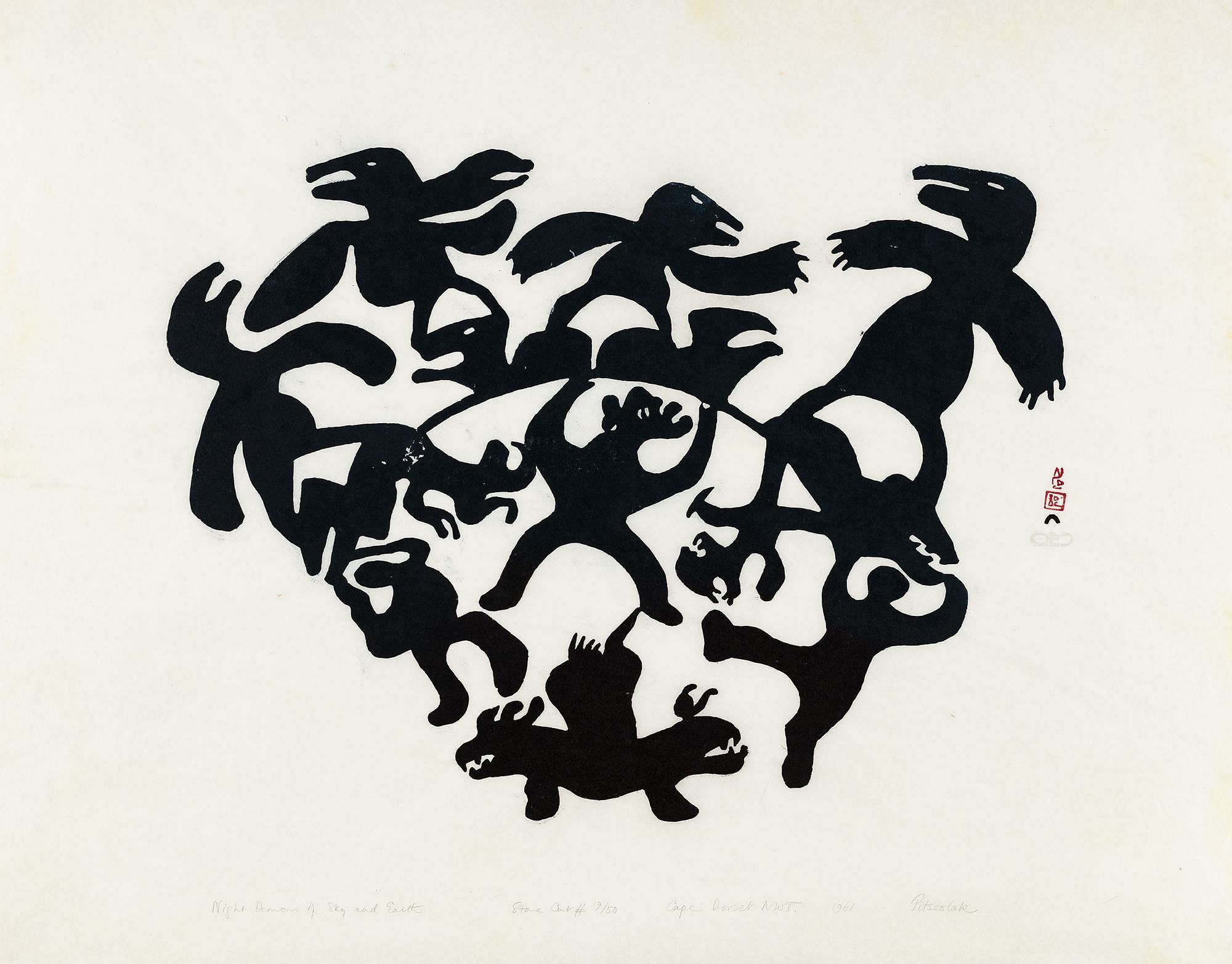PRESS RELEASE

Thirty from the Sixties: The First Decade of Inuit Printmaking
Jan 8 – Feb 28, 2015
"Thirty from the Sixties" presents thirty prints from the first decade of Inuit printmaking. The 1960s were a time for experimentation with new media and new techniques. The collection includes both naive and sophisticated images, and both hyper-realistic and wildly fantastic images. Cape Dorset is represented by twenty-five prints created by fifteen different artists, including Kenojuak Ashevak, Kananginak Pootoogook, Parr, Pitseolak Ashoona, Lucy Qinnuayuaq, Pudlo Pudlat and Kiakshuk. Povungnituk is represented by four prints created by Davidialuk Alasua Amittu and two other artists, and Iqaluit is represented by a single print by Henry Evaluardjuk.
Most of the prints are stonecuts -- prints produced by carving a negative image into the flat surface of a stone, inking the stone, and pressing the paper directly onto the stone. Most of the remaining prints are stencils -- prints produced by cutting the areas to be colored out of a template, placing the template over the paper, and applying ink through the openings in the template. (Although the stencils are frequently labelled "sealskin stencil," sealskin was never the material used for the template. The templates were waxed or oiled cardboard.) A small number of prints were engravings, and Henry Evaluardjuk's print is a linocut -- the same as a stonecut, except that the negative image was carved into a linoleum floor tile.
Each medium encouraged the artists to use different techniques. Stonecuts were initially black-and-white, and lent themselves to bold patterns. See Davidialuk's Loon Fishing for highly sophisticated contrasting patterns and textures. Artists soon learned that multiple colors could be applied to the stone, as in Pitseolak Ashoona's Man Repairing Sledge. Stencils lent themselves to expanses of color, often with subtle shading. See Pudlo Pudlat's Proud Walrus and Fish and Spear. Some prints, such as Lucy Qinnuayuak's Man Wants a Seal, combined both stencil and stonecut techniques. Engravings allowed the artist to depict very fine details. See Iyola Kingwatsiak's Bear Hunt and Quvianiatuliak Parr's At the Floe Edge.
Povungnituk prints differed from Cape Dorset prints in several respects. Early Povungnituk prints used the whole stone, and printed the stone out to and including the edge. This accounts for the irregular outline of Davidialuk's Loon Fishing and Annie Mikpigak's Hunting. In addition, in Povungnituk, the artist who designed the print also cut the stone.
In Cape Dorset, in many cases one artist designed the print, and another artist cut the stone and pulled the print. The influence of the printmaker can be seen by comparing the three prints by Parr in this exhibit. Walrus Hunt was printed by Lukta Qiatsuq, Children Chasing Dogs was printed by Iyola Kingwatsiak, and Seal Hunter was printed by Timothy Ottochie. (Iyola and Timothy both have their own prints in the exhibit.) All three capture the spikiness of Parr's pencil drawings, but Timothy presents a softer outline and detailing than the other two. He also uses solid color to emphasize the seal and the spear, while Lukta has no solid areas in Walrus Hunt, and Iyola uses solid black very sparingly, for one child's arms and legs.
